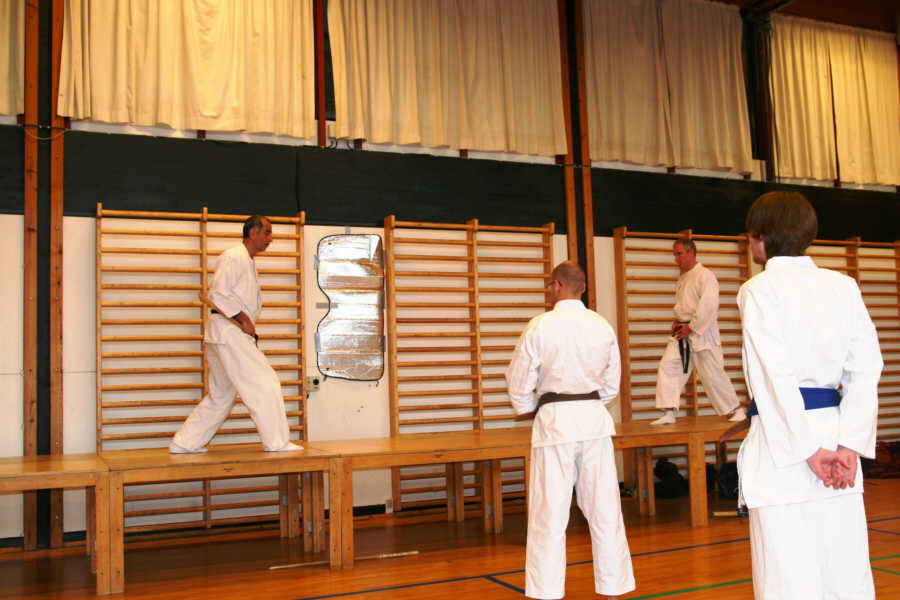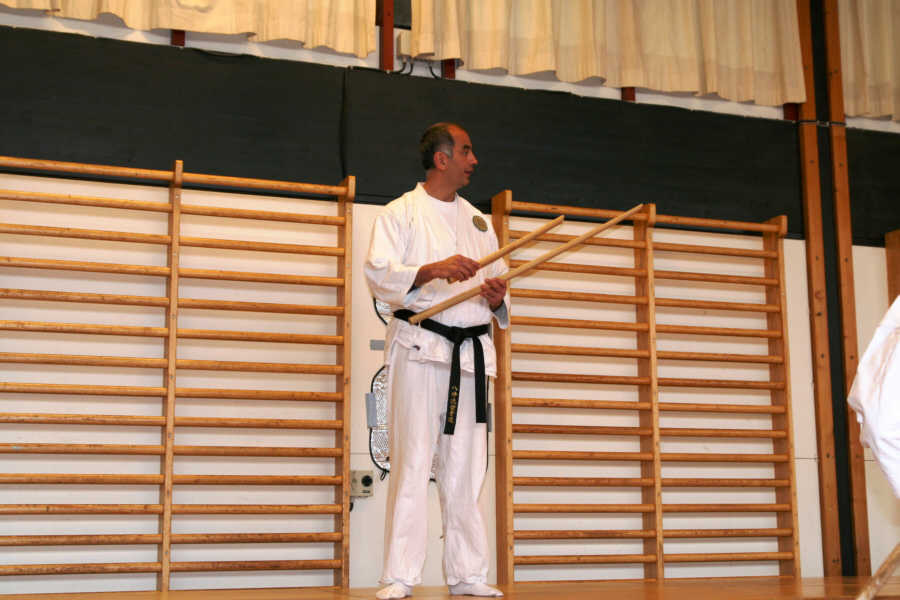
By Martin E. Hansen, Member until 2018
Kotachi course pack 2
Kotachi course package 2 is a skills course that requires a teacher at Menkyo level to be able to transfer knowledge correctly. Thus, Kimu Sensei taught this course and this possibly for the last time, as it will be handed over to the next instructor in line when it is repeated in approx. 2 years.
Saturday 7/11 2009 formed the framework for the first holding of the kotachi package 2 course. In total there were 47 registrants.
The classroom at Tjørnely School was oozing with anticipation and mixed with the smell of freeze-dried coffee and sweaty gi's it was a perfect atmosphere for Kimu Sensei to begin the theoretical Ryugi part of the course. Now it is that we are against all forms of doping in the Shindenkan, but Kimu Sensei was slightly doped that day as Martin Renshi-dai had brought his stock of throat medicines to lubricate Kimu Sensei's throat, who had to complete the day's course with a bad sore throat - long live Strepsils With their throats well lubricated, Kimu Sensei brought the course participants through a diverse powerpoint presentation, which briefly had the message of explaining the place of kotachi course package 2 in the structure of courses and at the same time giving insight into the common thread through courses and the increasing degree of competences. Once again, emphasis was placed on the fact that the knowledge we have in Shindenkan is more than 1000 years old and we must protect and trust it and not invent the deep dish again and again.
At the same time, we must not forget that it is martial arts that we are here for and it is about combat and in its origin it is life and death. We cannot train and test in the same way in modern society, so here it is about attitude and finding the motivation in everyday "battles". Everyone knows about problems at work, at school or in relationships. But instead of thinking negatively and in problems, you have to turn the "battle" and think positively and in solutions. With this your thinking becomes unlimited instead of limited and it is also martial art, very simple right?
Well filled up mentally, everyone moved towards the gymnasium where today's practical ryuha lesson was to take place. The hall was quickly filled with expectant and armed Shidenkaners, who were now to be masters of the art of knife fighting. The length of a kotachi is now also not far from a proper manly meat knife, from a respectably equipped kitchen, and judging by the satisfied expressions around the gathering, it felt good in the hand. Precisely the length of a Kotachi is the decisive difference from a Bokoto and the training in Kenjutsu. Not because the techniques differ so much, but the distance and thus the comfort zone is changed. For most people, this has a mental meaning when you go from distance to melee, which those who have participated in jujutsu and task fighting can nod in recognition and see a similar connection here. To illustrate this difference, a recap was first run on ken-jutsu package 2 and kotachi package 1 by Jens Kyoshi. Without realizing it, all the participants were "led astray and deceived" by Kimu Sensei, when he unnoticed led the students into kotachi package 2 part 1 (kumite).
Of course, there was a point to this and it was precisely to illustrate that instead of marking a transition for the students from something known, which would then automatically turn on the now-it's-getting-difficult button, they instead drove on in the same gear and naturally embraced kumite with kotachi without frowning. So you can do much more than you are told by others or yourself. Everyone was a bit thoughtful but also happy with their own abilities. Time had passed quickly, but a new kumite technique was created, as a taster for part 2, where, in Kimu Sensei's words, it will go at a furious pace. Now it was up to the students themselves and the local schools to get trained on the messages and techniques before part 2, so there was a war on the knife all around the small homes.
Time flies when you're having fun and 14 days later on 21/11 we were ready again, armed to the teeth and with an expectation that things would go fast, and they did - really fast. First, Kimu Sensei took us all through a short ryugi recap with the most important messages and essence from the first part of the course. It is important to understand that the kotachi course package 2, in addition to being a competence course, and for this reason alone an essential building block in the entire structure that builds our martial arts house, is also a "hub course". How is that to be understood? Quite briefly, you can also express it as the essence of the essence – it was easier A slightly deeper explanation follows.
The 4 main steps in Shindenkan & Kaidenkan are not there just for the sake of randomness and difficulty, there is a meaning to the madness You can read a lot about the structure and structure here at www.jokokan.com, so we leave that out here. Instead, we start from the entry system Yakami Shinsei-ryu karate do, which is the 95% in Shindenkan train and find their way through karate. At one point or another, everyone becomes aware that a curriculum is structured so that the student is constantly improving and gaining new skills in terms of karate. The curriculum of Yakami Shinsei-ryu Karate-do is very diverse and a huge work, and if you compare the curriculum alone with other karate systems, there are many more techniques and many more teaching hours required to achieve equivalent degrees. As you can also read about here on the website, it is one of the reasons why it takes longer to become a black belt in Shindenkan than in other martial arts systems. It is a harsh claim, but nevertheless it has been verified by both students who have cultivated other systems, but also based on what you can read on e.g. other systems' websites, where times for black belt and pensa are often freely available.
But the crux of the matter, to return to it, is that in addition to the curriculum, Shindenkan and Kaidenkan have a comprehensive course program that includes inspiration, curriculum and competence courses. All courses are created with the aim of adding knowledge other than the core competence, supporting or expanding this. The competence courses are the "most important", understood in the sense that you train the essence and principles, and they are added precisely at a time when it is most beneficial for the student, i.e. in the TG group that the student is in (Kotatchi package 2 is targeted at TG group 3; 4th-2nd kyu) Therefore, as written at the beginning of this article, it is also important that in order for the level not to be "watered down ” it requires an instructor of the Menkyo degree or above to hand over this competence to the next in line. From Menkyo, it is possible to teach a competence, as you can see the whole and the structure in the correct light and transfer knowledge without mistakes, thus giving the opportunity for the student to also learn it 100 % correctly. It is so important that competencies are taught 100 % correctly as they are the essence.

This step-by-step development of skills, where kotachi package 2 forms the core of melee and kumite, produces some very skilled and experienced practitioners, which substantiates the statement that a Shindekan student is typically 2-3 degrees above a corresponding student from another system - with security a notch above! Therefore, the target group for this course is directly comparable to a 1.dan in other martial arts systems. Kotachi package 2 is, as I said, a hub course, as it gathers knowledge and shows the common thread from ju-jutusu 1-3, kotachi 1, Instructor course 2, task fighting 3, ki & meditation 1 and the Shiatsu training. They all have in common that it is Ura-uchi – from the inside out, which is the essence of kotatchi package 2, which is melee, close and thus a small comfort zone. You are thus challenged on a mental level: how much do you trust yourself? dare to throw away control to gain full control?
Everyone was ready and equipped to go to war with the technical content of kotatchi pack 2 part 2. Learned from previous experience, everyone knew that there would be many new techniques and at a furious pace, so it was comforting to know , that in Shindenkan we train holistically and according to the essence, because what is better "train the essence and then train 100 techniques and consolidate the essence or train 100 techniques and maybe never understand the essence". So it's good that we got to know the essence and structure and then trained 81 + 36 combinations to consolidate the essence It was actually very well done to get through so many techniques and combinations in just under 3 hours! The structure was built as in Ken-jutsu package 2 according to THANKS MY CT (correct: Technique-Distance-Contact, correct: Mai ai-setting-Tai sabaki, Technique 2, Center and Timing) yes one must have been there to understand that The possibilities in kortachi are, as with so much else, almost endless, but with the basic pattern around 9 steps and 9 technicians per step i.e. 81 combinations + the loose + a little extra in the second power you can always add new techniques to the structure and consolidate the essence. With another course in the experience bank passed on by a unique bujutsu capacity, everyone can proudly say we have improved.
As the last thing of the day before everyone said a nice goodbye, Kimu Sensei could announce that Jens Kyoshi had started the last course on the road to the high densho degree Menkyo (Master of all the martial arts), to which everyone rightly clapped and nodded in appreciation - thus is the next resource who can and must teach competence courses secured if he completes.
I am sure that the others, like me, are looking forward to the competence graduation during this year's Christmas assembly, where I am sure that everyone will pass if they practice enough at home and in the local school. But be careful next time you slice the steaks at home, there are so many options!!!




